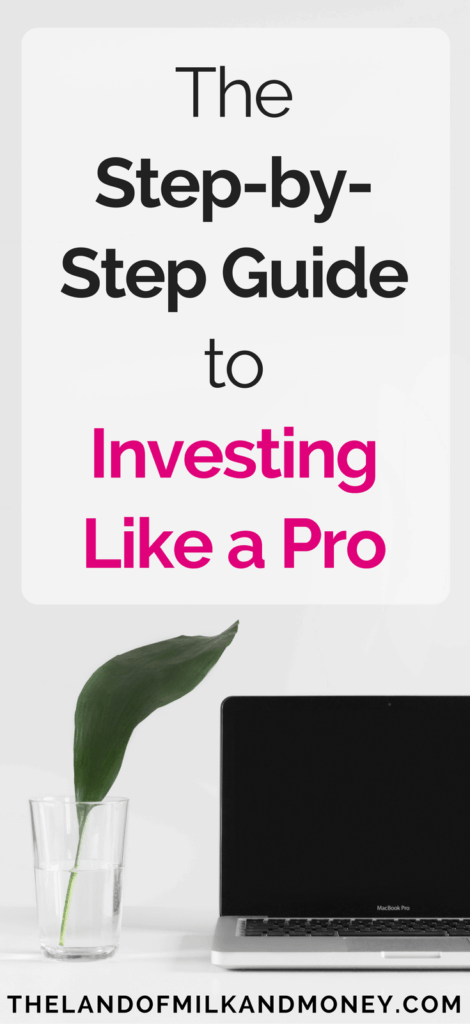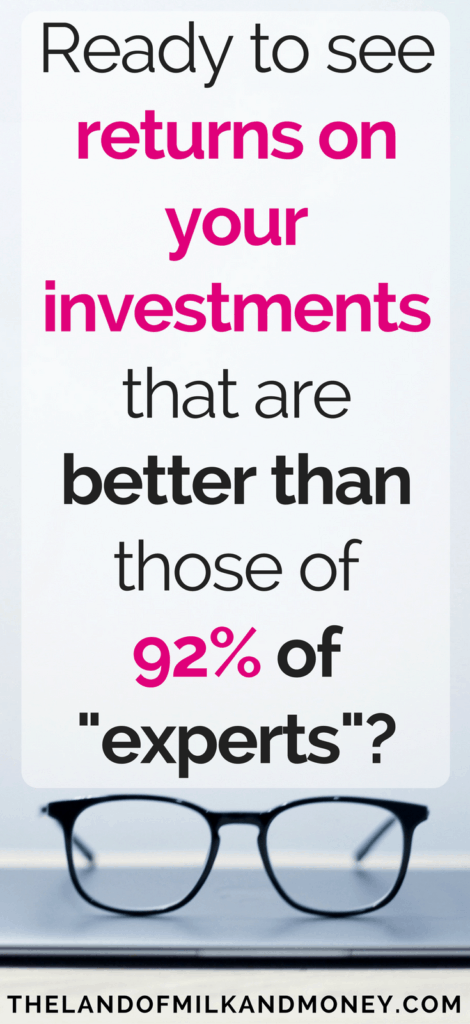Welcome to Step 6 of the Step-by-Step Guide to Investing Like a Pro!
You’ve reached the really fun part of the series. This is where you’ll be setting up your portfolio!
First, however, you should really consider reading the earlier Steps. These will set you up with the knowledge needed to put your new investing expertise into action.
- Step 1: The Beginners’ Guide To Investing Like An Expert (Including How To Beat The Professionals)
- Step 2: How To Invest Your Money For The Best Returns (For The Least Amount Of Cost and Effort)
- Step 3: How To Prepare For Risks To Your Investments – And Turn Them Into Rewards
- Step 4: The Simplest Investment Portfolio You Will Ever Need
- Step 5: Why Bonds May Save Your Life (Or At Least Your Portfolio)
Made it this far?

This presumably means that you’ve considered all of the information and are convinced that index funds are the way to go. Excellent decision!
You’ve also had a bit of a think and have a fairly good idea of your risk appetite.
Now you want to know how to split your investment portfolio so as to maximise your returns without creating more risk than you’re willing to take on.
Then welcome, dear reader, to your financial future!
Setting up your investment portfolio
There are, of course, any number of different asset classes that you can include in your portfolio
However, as I hope has been made clear in earlier Steps, just because something is more complicated does not mean that it will be more successful.
If anything, in the case of investments, it’s the opposite: the more complicated that something is, the more expensive it may be and, consequently, the more your returns may be negatively affected.
So I’m going to show you just how simple setting up your investment portfolio can be.
For the reasons set out in Step 4, I recommend using Vanguard for your investments.
As mentioned there, I am not an affiliate for Vanguard and thus I do not receive any money or other type of compensation for recommending them.
They are simply the company that I believe offers the best way to invest in index funds. I have used them for years and am a very satisfied customer.
The majority of your investments should (probably) be in stocks
Step 1 covers in great length why it’s best to hold the majority of your investments in stocks through investing in index funds that track the market (or certain sectors of the market).
In particular, VTSAX will provide you with everything you need: exposure to the entire US stock market, far lower fees than you’ll see with an actively managed fund, the reduced risks posed by index funds compared to owning individual stocks, and the ability to take advantage of the fact that stocks have, historically, seen the best returns of any investment vehicle.
However, as covered in Step 3, it can take nerves of steel to keep all of your money in an index fund that tracks the market. This is because, exactly like the market itself, prices can peak at the highest of heights and trough at the lowest of lows.
Depending on your risk appetite (which you should figure out by reading Step 4), watching all of your money rise and fall in this way may be more than you’re willing to take on.
And that’s ok!
This is why most people reduce their risk somewhat by also investing in a less volatile investment class.
Fortunately, you know exactly how to address this issue as you’ve read up on what bonds are and how they can help in Step 5.
How much should I invest in bonds and how much in stocks?
Ah, now this is the $1 million question! (Or however much you need to retire early.)
As mentioned in Step 4, I have decided that, for now, I will keep 100% of my money in VTSAX.
This is, however, a very aggressive investment strategy and is quite possibly not right for you.
So first step: read Step 4 and determine your risk appetite. That is, just how much will you start to feel nauseous each time the market dips.
Then you need to determine the extent to which you wish to reduce the risk posed by solely investing in an index fund. This is the percentage of your investments that should be held in bonds.
Keep in mind though that the greater the percentage of your portfolio that consists of bonds, the less your overall returns will be. You need to find a balance between having an acceptable amount of risk and ensuring that your money is working as effectively for you as possible.
But what is the correct percentage of bonds to own?
A common piece of advice is that you can determine the percentage of stocks you should hold by subtracting your age from 100. In my case, this would mean that my portfolio should consist of 69% stocks and 31% bonds.
Suffice to say, I do not agree with this particular advice.
31% of bonds is a huge amount for someone at my age and at my stage of their wealth-building process, considering how much this would detrimentally affect my returns. It’s likely to be far more appropriate for someone who has already retired.
Others advise that it may be more appropriate to subtract your age from 120. I would argue that this is much closer to the mark. For example, someone who is 50 should, based on this calculation, have a portfolio consisting of 70% stocks and 30% bonds.
Depending on an individual’s specific risk appetite, this sounds more realistic.
Of course, no single formula will ever work for everyone. This article, for example, breaks it down by age. For example, if you are in your 40s, it recommends that you own 20% to 30% of bonds.
The problem with this is that it assumes that your risk appetite is solely dependent on your age. We’ve already established in Step 4 that this isn’t true.
This article helps in providing some guidance. For example, it considers a portfolio of 80% stocks and 20% bonds as being “moderately aggressive” while a portfolio of 60% stocks and 40% bonds only allows for “moderate growth”.
One thing you may wish to consider is the outcomes of the Trinity Study discussed in this earlier post. This study demonstrated that if you can live off 4% of your portfolio value per year, you would be able to fund your lifestyle for thirty years (and, as shown later in the article, indefinitely) without earning an additional cent. As such, once your portfolio reaches this value, that is the point at which you will be able to retire.
However, as pointed out in that article, there are a few variables that make it more or less likely that you will, indeed, be able to live forever off your investments once your portfolio reaches the relevant amount. In the case of living off 4% of your investments each year, it is almost certain that you will be able to successfully do this if you hold 75% of stocks and 25% of bonds.
Ultimately, your decision on the percentage of bonds and stocks to hold largely depends on whether your focus is on preserving your wealth or building your wealth.
In the case of the former, having more bonds may be wiser. However, in the case of the latter, be wary of having too much of your money tied up in bonds and thus limiting your returns.
My advice to you is, generally speaking, follow the formula of subtracting your age from 120. I say “generally speaking” as you may be able to stomach more risk than this.
For example, this calculation assumes that I should hold 11% bonds, however I have chosen to hold none at this stage of my life. This will, however, inevitably change in the coming years.
Similarly, someone who is 65 should, based on this, hold 55% of stocks and 45% of bonds. This is quite conservative and may not be right for someone who sees that they probably have 30+ more years ahead of them and wants to continue to see some stronger returns.
At the same time, someone else of that same age may want to mitigate the risks of a potentially volatile stock market and be happy with reduced returns over the long term. In that case, that split of stocks and bonds may be perfectly acceptable to them.
Summary
At the end of the day, it’s up to you.
Simply figure out your risk appetite and use this to work out how much you are willing to split between stocks and bonds. If you feel yourself getting too stressed about the movements of the stock market and are willing to accept lower returns in exchange for less volatility, consider putting more money into bonds.
And with two simple purchases, you’ll have established the foundations of your investment portfolio to see you through the rest of your life.
That’s it! You’ve made it!
I trust that you can see now that investing is not only for the so-called experts. Particularly when these experts wish to charge you a small fortune for the pleasure of taking your money and, more often than not, performing worse than an index fund.
If you have any questions, please feel free to let me know in the comments.
Otherwise, just remember: the best time to start investing was yesterday. The second best time is today.
So, somewhere in the coming years, Future You is tipping his or her hat to Present You. After all, it’s thanks to Present You that he or she is far more financially comfortable than others! And it’s all due to the steps that you’re taking today to start building your portfolio.
Make sure Future You comes and joins Future Me for a glass of champagne somewhere. It’ll be my round – you’ve earned it!
Read the entire Step-by-Step Guide to Investing Like a Pro here:
Step 1: The Beginners’ Guide To Investing Like An Expert (Including How To Beat The Professionals)
Step 2: How To Invest Your Money For The Best Returns (For The Least Amount Of Cost and Effort)
Step 3: How To Prepare For Risks To Your Investments – And Turn Them Into Rewards
Step 4: The Simplest Investment Portfolio You Will Ever Need
Step 5: Why Bonds May Save Your Life (Or At Least Your Portfolio)
Step 6: How To Build Your Very Own Expert Investment Portfolio





5 comments
I love this series! I usually fall asleep reading any literature about investing (WHY IS IT SO BORING?), but your posts were incredibly helpful! I finally got the courage to open a Vanguard Roth IRA after reading all these, thanks!,
There is some seriously boring information out there about all of this, I so agree. But I’m really happy to hear that you took the plunge! Future you is bowing down and kissing your feet out of gratitude, I’m sure of it! 😉
Stocks provide the highest possible return but also, they are the most-risky investment because of the volatility of the stock market. The returns, though unpredictable, are higher in terms of capital growth and dividend.
Easybud delivery provides same day weed delivery within 2hrs to the Vancouver area. Weed delivery vancouver Take advantage of daily deals and discounts.
Easybud delivery provides same day weed delivery within 2hrs to the Vancouver area. Take advantage of daily deals and discounts. Every order placed with qualify you for a free gift.